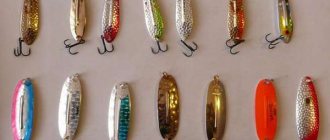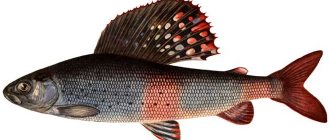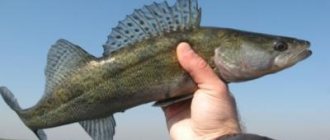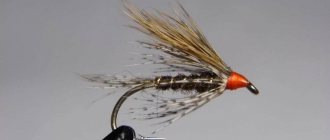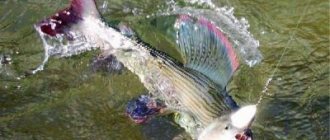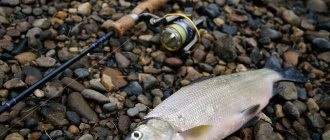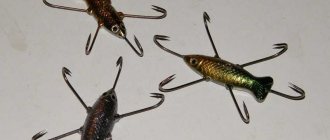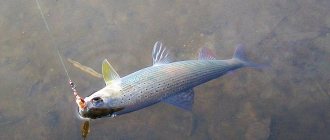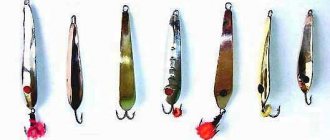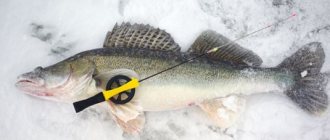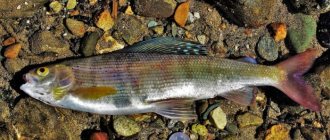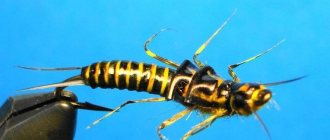Particularly good are small-sized spinners, the petals of which have various patterns, stripes, and dots on them. The most productive time for catching is September-October. The water level decreases, the boundaries of shallow water and deep-water holes become clearly visible.
Grayling belongs to the salmon family. It has 3 main types: European, Mongolian, Siberian. They also include many subspecies: Kamchatka, West Siberian, East Siberian, Alaskan, etc.
All of them differ from each other not only in name, but also in habitat, habits, color, and some other characteristics. The size will primarily depend on its living conditions, but on average they weigh from one kilogram to three or more.
A distinctive feature of all graylings is a huge fin on the back, it is dotted with various stripes and spots. The other fin on the back is adipose, medium-sized, making them similar to salmonids. This omnivorous fish can eat invertebrates, eggs of other fish, aquatic vegetation, larvae, worms, etc.
Habitats
In summer, in good weather, grayling can be easily spotted by their frequent splashes. In autumn this will be more difficult, but in September, when insects fall into the water, grayling will again actively eat them from the surface.
In spring it is especially active before spawning and for some time after it. In late autumn, the predator will begin to migrate, leaving small bodies of water for larger ones. It accumulates in deep-sea places, preparing for wintering.
Grayling will never actively pursue its prey. If he notices it on the surface, he will simply rush across it and instantly swallow it. And it will not swim to bait that is far from it. Therefore, the bait must be immediately thrown to the fish site.
This predatory fish prefers to inhabit fast-flowing, cold, clear waters. It is found throughout European territory, in the northern regions of Russia. In the southern habitats, grayling lives only in streams, mountain rivers, oxbow lakes, and deep-water lakes.
Fishing calendar by fishing season
- The golden time for spinning anglers to fish for grayling is August.
Winter. The best time is from March 20 until the opening of the reservoir. The rest of the time he behaves unpredictably. They are caught using jigs and donkas; pieces of freshly caught fish or a purchased mixture are used for bait.
- Spring. They fish in the summer style any way they like: with a wire, with a fly rod, or with a plumb line. Worms, silicone and dry insects, and maggots are used for bait.
- Summer. Immediately after spawning, grayling becomes voracious. For bait, the following will be especially good: dry and wet flies, larvae, worms. You can hunt for him at this time with any permitted gear.
- Autumn . Before the first ice, grayling bites well on almost everything: larvae, worms, insects, etc. You need to hunt by going lower to the rapids and riffles. In November-December, fish will bite only near reaches, dams, and deep holes.
What models of spinners are there?
Among the variety of rotating and oscillating spoons, there are several models that make grayling fishing the most effective.
Each of them has its own advantages:
- Blue Fox is the most popular model. It is available in both oscillating and rotating versions. It is also suitable as a lure for grayling because it has very strong hooks. The second model number is ideal for catching this fish. The color is selected individually (depending on the body of water and time of year).
- Daiwa is considered one of the best catching baits. The line also includes oscillating and rotating models. The balanced design shows excellent results in almost any type of reservoir with different currents, suitable for catching most fish and all types of fishing. For grayling fishing, the most suitable bait colors are gold and silver.
- Mepps Aglia No. 2 is called a miracle bait by fishermen. Its rotating petals easily adapt to the force of the current, while maintaining the desired vibration. As for grayling, it is perfectly caught on a silver model with red stripes.
Advantages of using spinners
The effectiveness and popularity of spinners is undeniable, namely:
- ease of use;
- long service life;
- a huge range of models, colors;
- work great even with cheap monofilament lines;
- during wiring they show increased resistance;
- weed out bites from small fish;
- the cost of the products is low;
- versatility of use;
- always arouses interest in grayling and easily provokes him to attack.
Spinners
If you decide to catch grayling in an unfamiliar body of water, then it is better to start with rotating spoons.
This type of lure for grayling is called a “spinner” by fishermen. The effectiveness of this bait is explained by its double action. In clear water, fish react to the glare spread by the rotating petals, and in muddy water they feel their vibration.
It has been noticed that such a spoon for grayling and lenka, with black dots applied to it, attracts the attention of fish much more than without them. Pinwheels come in different colors, sizes and shapes. But for grayling it is preferable to choose a heavy model with wide petals.
Rating of popular models
Each body of water has its own fishing nuances and preferences of aquatic inhabitants. Of course, there is no universal spinner. But there are some types of spinners that are used all over the world, and with which fishermen can hunt productively at any time of the year. We are pleased to present such models to you below.
Aglia Long
Aglia Long
This most awarded model has the shape of an elongated petal, with a deviation from the axis of rotation of 40°. And slight drag, which may vary. Much will depend on the wiring speed. This is the secret of its success - it is a wide range of movement speeds. But at the same time, the flawless play of the spinner is completely preserved. Therefore, it is suitable for almost all fishing conditions:
- a powerful hydroacoustic wave will attract a predator from long distances;
- they fish against the current in a wire;
- on very intense currents;
- in shallow water, with underwater vegetation, etc.
Lukris Spark
These spinners were designed primarily for fast currents. The elongated lightest “willow” petal, but the heavy core, can deviate up to about 30°. There may be some slight resistance during wiring.
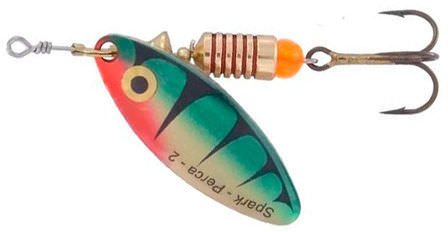
Lukris Spark
The depth for bait is 2-2.5 meters. The secret of catchability is that, regardless of the wiring and the strength of the current, the play of the spinner will remain stable. Its use is possible for other fishing conditions as well.
PantherMartin
Panther Martin
This bait is, in fact, a representative of the In-Line class. It is compact and therefore can be thrown over fairly long distances. Particularly winning colors: silver-green, golden-blue.
Sparkling scales are applied to the petal, which when rotated creates bright flashes of glare. The spinner is universal, stable in operation, regardless of the rotation speed and the rhythm of the wiring. It starts simply with a half turn.
Heintz
It’s catchy and incredibly effective, but you first need to learn how to cast it correctly and acquire the skill. With the right throw, once it hits the water, it begins to rotate, causing movement and getting the fish interested in this. The most productive colors: silver and copper.
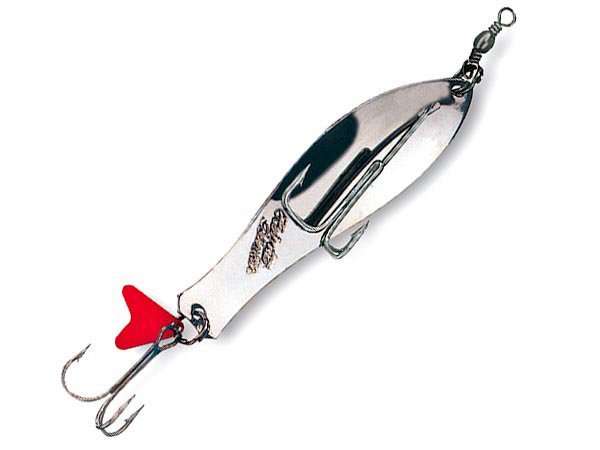
FZ Heintz Blinker
Has a pair of double hooks. The design is complex, but very successful, so there will be no fakes. It will be able to work equally well with different wiring: standing water, flowing. Its vibrations are complex, rhythmic and very high-frequency. Particularly intense vibrations occur in the tail section. First, set the desired tempo and reeling speed. And they twitch the tip of the rod. Available in different colors and weights:
- 10–27 gr. - greater efficiency can be achieved with combined wiring, with more frequent pauses and rewinding of the fishing line;
- from 27 gr. — more suitable for uniform wiring with continuously repeated accelerations;
- from 50 gr. - especially good for trolling.
Blue Fox
Blue Fox Super Vibrax
Rotating spinner with long casting. It has a special design with anti-twisting properties. Equipped with a VMC treble hook, has a feathering to camouflage the treble and the front sight. Weight 10 g, rotation angle 45°. Designed for depths from 0.8–1.5 m. There are rotating and oscillating options.
The color is selected based solely on the time of year, day, terrain characteristics, etc.
Mother-of-pearl and bright ones are especially in demand; they are more noticeable in the water. It is best to catch grayling on No. 2, the color is selected individually.
Gear requirements
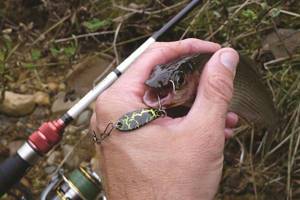
A spinner for catching grayling does not require a specialized spinning rod. To work with this type of bait, standard fishing rods are used, selected based on the weight of the spinners used. Since baits are light in weight, it is most appropriate to use rods for ultralight and light fishing. As a rule, light tackle tests do not exceed 15–18 grams.
Important! To control the progress of baits and clearly detect bites, it is preferable to choose a spinning rod with a fast or semi-fast action.
When fishing for grayling, the length of the gear falls within the range of 1.7 to 2.5 meters, and its weight should be as small as possible. Plug-in graphite and carbon-fiber rod models with cork handles are lightweight. Reels are selected for the gear, also paying attention to the low weight of the mechanism. The mechanism itself does not require any special functionality. All you need is an adjustable clutch. According to the size of the spool, spinning reels are used with markings from 1000 to 2500. The cord can be used either braided, from 0.1 to 0.15 mm, or monofilament up to 0.2 mm in diameter.
Important! To make the equipment thinner and especially delicate, fasteners are not used; the bait is tied directly to the cord through a miniature swivel.
Tackle equipment
Each fisherman selects fishing gear individually. Today this is not difficult to do, stores are filled with: spinning rods, fishing rods, bottom fishing rods, fly fishing rods and all kinds of devices. The main elements of any tackle: rod, line, float and sinker.
It is more convenient to catch grayling using a spinning rod or fly fishing. Fly fishing, of course, has more advantages, but it is more difficult to master. But you don’t need to frequently move from one place to another, but it is used only in open spaces, not overgrown banks.
In hard-to-reach places, it is most convenient to fish with a spinning rod. Their catchability is approximately the same. The length must be selected based on fishing conditions. Equip with a thin braid of 0.1 mm.
You can tie a leash, but if the bottom is not very clean, then it is better to refrain, there will be fewer snags. Buy hooks without barbs, use a landing net.
Gear for small bodies of water:
- rod blank of medium or fast action;
- test 1–8 g;
- length 2–2.3 m;
- monofilament line, without a leash;
- The bait is tied without the use of swivels.
Rod
The optimal fishing rod is a telescopic, one-handed spinning rod:
- 190 cm with dough 2–25 g;
- 250 cm with dough 5–50 g.
The rod should be short in length so that it can be quickly assembled/disassembled; it should be convenient and mobile.
Why two? A short one will be needed for fishing in small bodies of water where long casting is not needed. Longer for longer distances.
Coil
The main rule is the proportionality of the rod and reel , you need to feel it. A lighter version is preferable. Durable, made of lightweight but durable metal alloys:
- inertia-free coil;
- presence of a high-speed stopper;
- friction brake (gear ratio 5.1);
- minimum 4 bearings;
- replaceable metal spools.
fishing line
Perfect for:
- high-quality monofilament with a thickness of 0.21–0.25 mm, or braided 0.1 mm;
- tie the lure directly to the fishing line;
- The color of the fishing line should be two shades: greenish and blue.
Hooks
Hooks must be sharp and barbless. You can disguise it a little with thread, hair or tinsel.
Best lures
For catching this fish, small wobblers, about five centimeters long and weighing no more than five grams, are best suited as bait.
But, in an unfamiliar body of water, it is always better to start fishing using spinners, and if there is no result, then you need to replace it with a smaller bait. You can also change the color of the bait itself; perhaps it is this negative factor that influences the grayling’s desire to eat the bait.
You should use wobblers only after the place has been checked for the absence of various snags, because the place must be clean.
But sometimes it is impossible to do this, because in some reservoirs the color of the water does not allow you to see the bottom.
In order to successfully fish for grayling, it is imperative to take into account both the length and width of the wobblers.
The length of the wobbler should be no more than five centimeters, because it is large baits that can scare away the fish.
It is best to choose models whose length is four centimeters, SSR, SR. The wobbler's vibrations should be frequent and not very sharp.
You need to have wobblers of different buoyancy. For slower sections of water, floating models are best. And to catch this fish in a powerful stream you need to use sinking baits.
The equipment of a spinning rod for catching grayling is completed by setting artificial baits, the focus of which varies from the use of fly fishing flies to the more well-known and familiar to a wide range of anglers, popular in catching other freshwater predators with spinners and wobblers. In grayling fishing, the rule is perfectly confirmed that when serving a larger bait, the angler has the right to count on a larger trophy.
But an obstacle to its implementation is the fact that most often spinning fishermen catch fish weighing 400–500 grams. And as they say, they can’t handle large baits, the size of which does not exceed 5–7 cm. Wet flies of natural, discreet colors are placed on a spinning rod for catching grayling, and we will dwell in more detail on the choice of wobblers and spinners suitable for grayling hunting, having examined each type of bait in extended angles.
Spinners
A rotating spoon is the best option for catching predators in shallow, up to 3 meters, reservoirs. Separately, for fans of spinning trout hunting, we note that the choice of catchy spinners for grayling is quite consistent with promising baits for catching the more famous predator. A good example of a predator-proof spinner are models of spinners similar to the Mepps type Aglia or the Comet variation.
For a medium-sized trophy, numbers 1 and 0 are suitable. In sunny weather, dark petals with distinct yellow or red dots are used. In cloudy weather, pure silver tones are promising. In turbid waters, catchy unnatural exotic colors work. In clear water, natural colors are more visible.
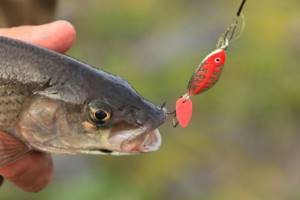
The spinners used must have a stable motion, because frequent failures in the rotation of the petal and its late activation do not bring comfort to fishing in fast currents, and they also scare away cautious and suspicious predators from the fishing trajectories.
Wobblers
Wobblers for grayling have much greater capabilities compared to other types of artificial bait. So, with wobblers you can fish deep-sea areas, regardless of the strength of the currents, and, depending on the fishing conditions, you can select styles and speeds of retrieve that match the mood of the fish.
Suspenders provide optimal fishing conditions. These models are used to fish the water column at different levels. At depths, they use sinking versions of wobblers, which more quickly reach the depth horizons needed for fishing. The color of the wobbler is significant only when fishing in shallow waters, where the color is selected by analogy with the choice of the color of the spinner, taking into account the illumination and transparency of the water during fishing.
At depths, wobblers in natural whitish colors reminiscent of fish scales are used. The disadvantage of wobblers is considered to be their high grip, but otherwise the preference of choice for spinning anglers remains precisely this type of artificial bait, which is more universal in use and is often more catchy than others.
Fishing technique and tactics
Fishing tactics
The most important thing in the beginning is finding fish. If there is no bite for a long time, then you shouldn’t linger in this place for a long time, move on. But if you catch at least one specimen, then continue fishing.
Fish the entire area thoroughly, and you definitely won’t be left without a catch.
When there is no bite for a long time, change baits, look for another area, in general, don’t sit still if you want to feast on fish.
You found a catchy place and, after hunting for a while, you left, deciding that you would no longer be able to make money there. You are very mistaken, you should return there in a few hours and try your luck again. Because the most secluded vacated places will usually be immediately occupied by other individuals.
Fishing technique
As previously noted, it is unusual for grayling to chase bait that is rapidly swimming past it. That’s why they use smooth winding to attract the predator and force it to attack. This is why you need high-quality spinners.
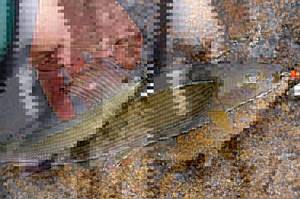
Fishing technique:
- We carry out wiring against an intense current. We wind the fishing line very slowly and with stops.
- We perform transverse casting of the equipment - a classic of the genre, and diagonal wiring.
- We throw the gear across the current, where the main work should be done by the current itself; it will carry the bait past the nose of the grayling.
Wiring selection rules:
- If a small stream flows into a large river or lake, the spoon is thrown into the mouth of the water area. And we consistently pull it down and a little to the side. We move to a relatively calm area. A turbulent stream bordering on a calmer surface of water is their favorite.
- Not far from the rocks, casting is done from a boat and towards the shore. And then you need to make throws around the boat. In both cases, wiring should be done slowly with short pauses.
- Throw the bait into the river up to a maximum of 50°, the main thing is to prevent further immersion. Next, slowly pull it in so that it moves downstream. The lower the speed, the more profitable the spinner will look.
Method of catching grayling with a spoon
Catching grayling with a spoon has many advantages, but it is worth noting the most important one - it is sifting out small fish from large ones. After all, grayling is a predator, and a not very large spoon can tempt it.
One of the fishing methods practiced by fishermen is very effective. To do this, you need to go into the water and stand about a meter from the beginning of the riffle, where it is shallow and the water rushes downstream to a deeper area.
The lure needs to be thrown onto the riffle, and it needs to be thrown into a calmer area of water, and after that, very slowly you need to lead the lure to the very beginning of the riffle. And it is at that moment when the bait touches the calmest place on the pond that a bite occurs.
From all this, the conclusion suggests itself that grayling is usually located on the border between calm water and fast current.
Fishing technique
Although grayling is a predator, it is not a pronounced predator, and it will not catch up with fast-swimming prey. It will not catch up with the wobbler, which will swim very quickly. Therefore, you need to constantly and evenly reel in the fishing line; these actions must be performed carefully and slowly. When fishing, the quality of the wobbler comes first.
Casting and wiring rules
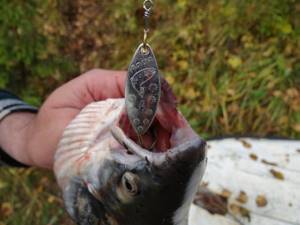
There are some rules that allow you to cast and retrieve as efficiently as possible.
For example, the classic retrieve for catching grayling is a cross cast, followed by a slow retrieve. This wiring must be done against the current.
Reeling in the line must be done slowly, even with pauses, and as a result the bait must move against the current and approach the shore.
For fish that are a little lazy or overfed, you need to throw a light bait that should move against the current.
And even the most passive fish will not be able to ignore the prey that is heading towards it.
Tips and tricks
- For bait, rotating spoons of bright colors, various patterns, and small sizes are more appropriate.
- The gear should only be of high quality, comfortable, and preferably light.
- The bait needs to be presented not just the right way, but the right way.
- There is no universal wiring and there cannot be; only experience will help you find the best option.
- If fishing on the track, use only oscillating spoons.
- In deep-sea reservoirs with strong currents, it is advisable to use heavy spoons.
- In quiet places and short distances, light spoons should be used.
- Heavy ones are suitable for moderate, fast currents (depth 2.5–4 m).
- In sunny weather, it is necessary to use spinners that do not produce bright glare.
- If the fish is interested in the bait, but does not bite, stop reeling for a few seconds.
Grayling is a noble representative of the underwater world. That is why he is so prone to being overly cautious. Hunting for grayling will require both a creative approach and complete preparedness from the hunter. Properly equipped gear, suitable bait and a good place will help not only to hunt successfully, but also to catch the coveted trophy specimen. Happy fishing!
Oscillating spoons for grayling
Spoon baits are also widely used when catching this predator. These are mainly relatively small spoons, the length of which rarely exceeds 4-5 centimeters. However, when fishing with these baits, you should take into account the fishing time - if a lot of insects fall into the water, it is better to use something more reminiscent of an insect that has fallen into the water, for example, it could be a small unloaded rotating spoon.
Important! An inexpensive oscillating spoon can work well, but the rings and hooks on budget models are usually of disgusting quality; before going fishing, they should be replaced with something more durable and of higher quality.
Also, we should not forget that miniature oscillating spoons designed for trout fishing are quite suitable for grayling. A large selection of shapes, colors and sizes of these spoons allow you to choose the right option for any fishing conditions.
Popular manufacturers and models of spinners
The following are quite popular among turntables:
- “Aglia Long”, “Comet”, as well as “Lusox” from the legendary.
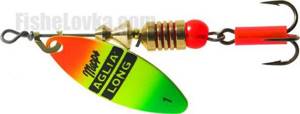
Photo 1. Aglia long spinner.
- "Daiwa" "Silver Creek Spinner", which is compact and heavy. The load is made in the shape of a fish.
- "Blue Fox" is a "Super Vibrax" model that maintains stable operation at minimum wiring speed.
- The “Panther” “Martin” is also considered by a number of anglers to be a very catchy spinner.
- "Pontoon21" "Trait", characterized by stable play.
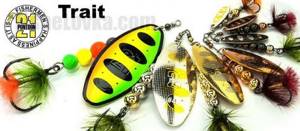
Photo 2. Spoons “Pontoon21” “Trait”.
All of these spinners are distinguished by their fairly high versatility - they catch not only grayling, but also pike, perch, and 00 numbers sometimes work even on peaceful fish.
Many fishermen consider the following to be catchy spoons for catching grayling:
- "Mepps" "Syclops".
- "Acme" "Little Cleo"
- "DAIWA" spinners "CHINOOK" and "CRUSADER".
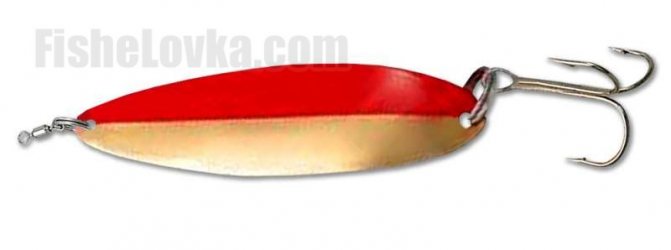
Photo 3. Spinner “DAIWA” “CHINOOK”.
- "RIVER OLD" model "Satelite Maximum Vespa".
- Miniature trout "Jackall" "CIBI TEARO" and "Apeed".
